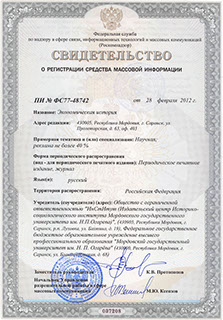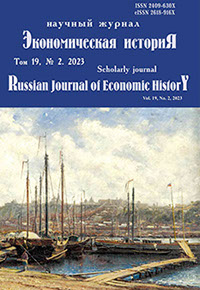Экономическая историЯ
Russian Journal of Economic History
ISSN 2409-630X (Print)
ISSN 2618-916X (Online)
Expert board:
- Scientific Council of RAS on economic history;
- Research and Educational Center «The economic history of Central Russia and the Middle Volga region» of Ogarev Mordovia State University;
- Center of Economic History of Lomonosov Moscow State University
Navigation
Certificate of registration

ISSN 2409-630X (Print), ISSN 2618-916X (Online)
DOI: 10.15507/2409-630X.061.019.202302.169-176
Oleg I. Mariskin
National Research Ogarev Mordovia State University (Saransk, Russia),
е-mail: mariskinoi@mail.ru
Agriculture of Mordovia in the Conditions of Reforms of the Early 1990s
Abstract
Introduction. The article examines the transformation of the agricultural industry in Russia during the transition to a market economy. The essence of the reforms consisted in a comprehensive change in the entire system of agrarian relations, including land ownership and other means of production, systems of farming and economic management, the transformation of the intersectoral and territorial structure of agro-industrial production, etc.
Results and Discussion. In order to form a new organizational and economic structure of the agricultural sector, at the end of 1991, the Government of the Russian Federation adopted regulations on the reorganization of collective farms and state farms and the procedure for the privatization of state agricultural enterprises. It was assumed that the arrays would be gradually withdrawn from collective and state farm land use in order to provide them to farmers without upper restrictions on the size of allotments.
By 1994, more than half of agricultural enterprises in Russia had chosen new organizational and legal forms of management, and preference was given to various types of partnerships. In Mordovia most enterprises in the agricultural sector have retained their former status as a collective farm or state farm.
The course of the ongoing reforms was accompanied by a decline in production, a decrease in livestock, the cost of agricultural products, sharp deterioration in the financial condition of agricultural enterprises. Even in these difficult years, when reforms were carried out inconsistently, and sometimes some attitudes contradicted others, part of the farms of Mordovia worked relatively steadily, made a profit, regularly paid salaries to employees, had a good profitability indicator.
Conclusion. As a result of the reorganization of collective agricultural enterprises, a significant step was taken towards the creation of a multi-layered agrarian economy based on equality of all forms of ownership and methods of land management. However, this did not bring tangible positive results in increasing the efficiency of agricultural production in the 1990s.
Keywords: reforms, peasantry, collective farms, farming, agricultural industry, Mordovia.
For citation: Mariskin O. I. Agriculture of Mordovia in the Conditions of Reforms of the Early 1990s. Ekonomicheskaya istoriya = Russian Journal of Economic History. 2023; 19(2): 169–176. (In Russ.).
DOI: 10.15507/2409-630X.061.019.202302.169-176.
© Ogarev Mordovia State University. History and Sociology Institute, 2017
68, Of. 411, Bolshevistskaya St., 430005, The editorial office of the scholarly journal «Russian Journal of Economic History»
Tel.: (8342) 24-25-90; 27-07-11, Fax: (8342) 24-25-90, E-mail: jurnal-econom-hist@isi.mrsu.ru
Designed by A. Napalkov, Email: napalkov@isi.mrsu.ru

